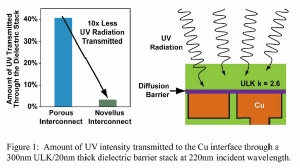May 6 2009
In order for RC delay to continue to scale in accordance with the International Technology Roadmap for Semiconductors (ITRS), device manufacturers are integrating ultra-low k (ULK) dielectric materials into their 32 nm process flows. At the same time, UltraViolet Thermal Processing (UVTP) is being introduced into the semiconductor manufacturing process to improve the mechanical properties of these ULK materials, making them more robust for subsequent Chemical Mechanical Planarization (CMP) and packaging operations. However, the UVTP process can alter the nature of the stress of the ULK film stack at the copper-dielectric interface. While it is widely accepted that maintaining a compressive stress at this interface can positively impact copper electromigration and film stack reliability, exposing some dielectric films to UV radiation can shift the stress in the film from compressive to tensile, which will negatively affect device performance.

Novellus (NASDAQ: NVLS) has developed a suite of 32nm dielectric films which significantly reduce the transmission of UV radiation to the critical copper-dielectric interface, maintaining a compressive stress in this region and hence device reliability. Figure 1 shows that the Novellus interconnect stack, consisting of a dense ULK and a low-k diffusion barrier, transmits an order-of-magnitude lower UV intensity (220nm wavelength) in comparison to a porous ULK solution. The improved UV absorption of Novellus' ULK film stack is a direct result of the chemical composition of the film.
"Some 32nm ULK inter-metal dielectric and diffusion barrier films can be negatively impacted by UVTP, changing the stress on the underlying copper-dielectric interface," said Andy Antonelli, technology manager at Novellus' PECVD business. "Relative to competitive offerings, the greater UV absorption capabilities of the new Novellus films preserves the compressive stress at this critical interface and thus minimizes reliability concerns."
For more information regarding the use of dielectric diffusion barriers resistant to UV, go to www.novellustechnews.com.